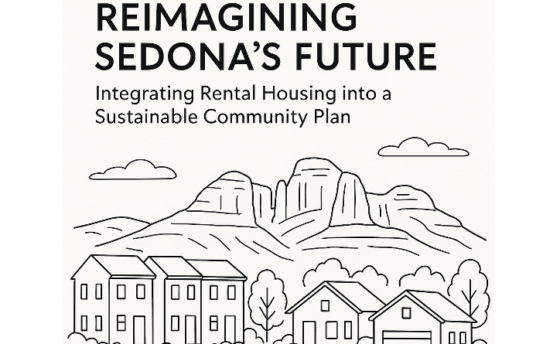By Bear Howard —
Sedona, AZ — Since the end of World War II, American communities have been built on a powerful cultural ideal: the single-family home on its own parcel of land. That image—lawn, driveway, privacy—became a proxy for the American Dream. Yet as towns like Sedona, Arizona confront the 21st-century realities of housing scarcity, workforce displacement, and economic dependency on tourism, the rigid lines between “owners” and “renters” have become not just outdated but self-destructive.

Sedona’s situation is stark: around 4% of its homes were built as rental housing, in a city of under 10,000 residents. At the same time, thousands of workers commute daily from the Verde Valley to serve Sedona’s hotels, restaurants, galleries, and essential services. The city’s economic engine runs on labor that cannot afford to live within its boundaries. Zoning—often considered an abstract planning tool—has thus become the moral battleground over what kind of community Sedona truly wishes to be.
Modern zoning in the United States began with the 1926 Supreme Court case, Village of Euclid v. Ambler Realty Co., which upheld cities’ right to segregate land uses—residential, commercial, and industrial—in the name of public welfare. After World War II, federal mortgage policy and suburban development norms hardened this separation further, promoting single-family detached housing as both a social good and a financial instrument.
The unspoken social logic was equally powerful: homeowners were “invested citizens,” while renters were “transient.” Cities, seeking tax stability and electoral support, privileged homeowners through zoning codes that insulated them from perceived risks—be they noise, traffic, or “undesirable neighbors.” Rental housing, especially multifamily dwellings, was thus culturally coded as inferior or invasive.
Over the decades, the “Not In My Backyard” (NIMBY) reflex became deeply entrenched. It masked class and sometimes racial biases behind the language of “neighborhood character” and “property values.” What was once intended as urban planning became social sorting.
Since the 1990s, a countercurrent has emerged: Smart Growth, New Urbanism, and mixed-use development have challenged the assumption that separation equals safety. Cities throughout America have experimented with zoning overlays that allow townhomes, accessory dwelling units, and apartments adjacent to single-family homes—recognizing that healthy communities depend on diversity not just of people, but of housing types.
However, even in progressive or environmentally conscious communities, resistance persists. Homeowners still wield political influence, and city councils often weigh a handful of angry voices more heavily than the silent majority struggling to find housing.
Sedona embodies this contradiction. While its brand evokes open-mindedness and creativity, its zoning politics often mirror those of affluent enclaves: fiercely protective, defensive, and resistant to change—especially near established single-family neighborhoods.
Sedona’s challenge is unique in geography but universal in pattern.
- Population: ~10,000 permanent residents.
- Workforce: Thousands more commute daily from Cottonwood, Camp Verde, and Rimrock.
- Housing stock: ~ 4% purpose-built rentals.
- Zoning pattern: Dominated by low-density single-family lots, with only isolated clusters zoned for multifamily housing.
Whenever the City of Sedona entertains proposals to upzone land near single-family areas—whether for duplexes, townhomes, or apartments—the pushback is swift and loud. Residents argue that “rental density” threatens neighborhood tranquility, traffic safety, or visual harmony. Some statements—veiled or explicit—suggest deeper fears: that renters will be lower-income, transient, or otherwise “not our kind of people.”
To avoid the bruising political fights these cases ignite, city leaders have resorted to a pragmatic but imperfect strategy: using commercial or light industrial zoned parcels for multifamily projects instead. While this sidesteps NIMBY backlash, it relocates housing to areas often far from schools, parks, or walkable amenities—further entrenching the idea that renters belong “elsewhere.”
Not long ago, the City of Sedona made a bold move—spending $22 million to purchase the 40-acre site once known as the Cultural Park, now rebranded as the Western Gateway. It seems the city Council thought this land on the edge of town that needed rethinking was the door opener actually to pursue rental housing in quantity being built in Sedona.
The vision was clear and commendable: to finally take control of Sedona’s housing future and create a master-planned community with a meaningful share of rental and workforce housing. For a city where only a sliver of homes are available for rent, it was a promise of balance and hope.
But today, that vision is mired in politics. The idea of townhomes and apartments—essential, attainable housing for teachers, servers, nurses, and first responders—has become a lightning rod for controversy. The very people who champion the “community spirit” of Sedona often recoil when the conversation turns to building homes for the people who make that spirit possible. The familiar chorus of “not in my backyard” echoes once again across the red rocks.
Meanwhile, another faction dreams of resurrecting the long-defunct amphitheater, a relic of past ambition that went bankrupt decades ago. Their nostalgia, while understandable, risks derailing a plan meant to address Sedona’s most pressing challenge: the lack of places for real people to live.
When the city bought that land, everyone knew why. It wasn’t to build another hotel, or to preserve a ghost of what once was. It was to ensure that Sedona’s future wasn’t priced out of existence. The land was purchased to give working people—those who serve, teach, protect, and enrich this community—a fighting chance to live here. To forget that purpose now would be to betray the very reason the city made that courageous investment in the first place.
By continually yielding to homeowner resistance, Sedona risks far more than delayed construction. The long-term costs are structural:
- A city that depends on imported labor becomes vulnerable to rising fuel costs, commuter burnout, and worker shortages. Every mile a worker drives to Sedona erodes the sustainability of its tourism-driven economy.
- Over time, zoning decisions create social geography. By walling off neighborhoods from rentals, Sedona narrows its demographic and economic diversity—producing an aging, wealthy, and less adaptable population.
- A community that celebrates spiritual inclusiveness while rejecting mixed-income housing undermines its own ethos. The gap between rhetoric and reality breeds cynicism, especially among younger generations.
- Long commutes and sprawl beyond Sedona’s borders contradict the city’s professed environmental values. More local housing would reduce carbon emissions and preserve open space beyond city limits.
Across Arizona, a quiet power struggle is emerging. Frustrated by cities that block new housing, the state legislature is pushing bills to override local zoning rules that favor single-family homes and exclude renters. The aim: break the grip of NIMBY politics that have made Arizona increasingly unaffordable.
For Sedona, the stakes are high. If the state prevails, the city could lose the ability to reject townhomes or apartments near single-family neighborhoods. The firewall protecting Sedona’s low-density image would weaken, opening the door to the kind of housing the community desperately needs but rarely approves.
Supporters see this as overdue reform; critics call it overreach. Yet Sedona must face a hard truth: when every neighborhood says “not here,” no one who works here can afford to stay. The state may be forcing Sedona’s hand—but perhaps it’s also giving the city a chance to redefine what “home” really means beneath the red rocks.
These shifts recognize that the mid-20th-century zoning template no longer serves 21st-century realities. They also affirm that rental housing adjacent to ownership housing is not only normal but necessary.
For towns like Sedona, these examples offer a roadmap for gradual adaptation—overlay zones, form-based codes, and inclusionary housing incentives that reward integration rather than avoidance.
If Sedona continues to let fear dictate its zoning future, it will pay a profound price. That price will not come as a single collapse but as a slow attrition of vitality:
- Fewer young families.
- Vanishing local workforce.
- Aging infrastructure with no one left to service it.
- A “museum town” where the lights stay on for visitors, but the community’s pulse fades at sunset.
In short, the price of protecting every view is losing sight of the future.
Cities are moral ecosystems as much as physical ones. When a town refuses to allow renters to live alongside owners, it quietly declares that belonging must be purchased. Sedona’s destiny—whether as a living, breathing community or as a postcard preserved in amber—will be determined not by its red rocks, but by its zoning map.
- Adopt mixed-density overlay zones near existing single-family areas, coupled with design standards to maintain aesthetic continuity.
- Reframe communication: emphasize that renters are teachers, artists, firefighters, and caregivers—the backbone of Sedona’s daily life.
- Pilot one integrated neighborhood as a proof of concept: owner-occupied and rental homes side by side, sharing trails, open space, and pride of place. The Western Gateway project could be a good place to start this type of new neighborhood.
The story of zoning in America is ultimately about who we believe deserves to live among us.
Sedona stands at that crossroads now. It can protect the illusion of exclusivity—or it can embrace the reality of interdependence. Every city must choose its own destiny. For Sedona, that destiny will be drawn not in sandstone, but in lines of zoning ink.
Sedona needs leaders with the courage to rise above NIMBY pressure and make choices that serve the greater good. The city’s future will only remain bright if it embraces creative, forward-thinking land use that reflects modern realities and progressive planning




